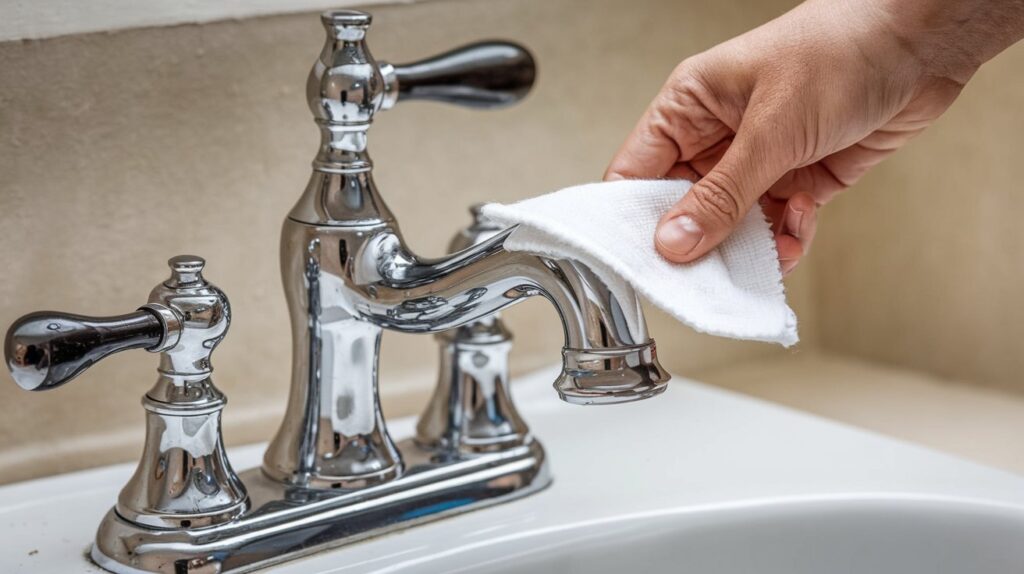Limescale, an unwelcome guest in our homes, often appears as ugly white deposits on taps, showerheads, and tiles. This mineral buildup, primarily composed of calcium carbonate, thrives in areas with hard water, leaving homeowners struggling with both unsightly stains and functionality issues.
In this article, we will explore why limescale forms, effective methods to prevent it, and expert tips on how to remove limescale from your home, ensuring your fixtures shine like new and work as they should.
What is limescale and why does it occur?
Water hardness is a term often thrown around, but what does it mean? Essentially, hard water contains higher levels of minerals such as calcium and magnesium. When hard water evaporates, it leaves these minerals behind, forming limescale. Areas in your home that particularly suffer are those frequently exposed to water, like kitchens and bathrooms.
Picture this: You’ve just returned home from a long day, you turn on the faucet and find that the water flow is sluggish, your showerhead sprays like a novocastrian garden sprinkler, and your tiles are adorned with unattractive white patches. Frustrating, isn’t it? Not only is limescale an eyesore, but it also lowers your water flow and can even shorten the lifespan of your appliances.
Preventing limescale buildup
While dealing with limescale is never a pleasant task, preventing it can make your life easier in the long run. Here are some proactive measures to keep your home limescale-free:
1. Soft water systems
Investing in a water softener can significantly help. These systems reduce the hardness of the water, effectively inhibiting limescale formation. They work by replacing calcium and magnesium ions with sodium ions, providing you with softer water that won’t leave behind those pesky deposits.
2. Regular maintenance
Just like any home component, your fixtures also require attention. Cleaning them regularly with appropriate non-abrasive cleaners can help keep limescale at bay. Make it a routine to clean faucets and showerheads monthly, preventing the buildup before it becomes unmanageable.
3. Vinegar as a natural solution
This kitchen staple isn’t just for salad dressing! Vinegar can effectively counter limescale deposits. Its natural acidity helps dissolve mineral buildup. Simply soak a cloth in vinegar and wrap it around the affected area, letting it sit for a few hours before wiping clean.
Effective removal methods
Despite all preventive measures, sometimes limescale simply refuses to budge. When that happens, efficient removal strategies are key. Thankfully, you have a multitude of options at your disposal:
1. Commercial limescale removers
For a more effortless solution, consider using a commercial limescale remover. Products from reputable brands like HG are formulated to tackle tough builds with ease. If you’re unsure where to start, check out their how to remove limescale guide, which details the best products for various surfaces in your home.
2. Baking soda and water paste
If you prefer a DIY approach, mixing baking soda with water can create an effective paste. Apply it to the limescale-ridden areas, scrubbing gently with a sponge. The alkaline nature of baking soda works to neutralize the acids in limescale, breaking it down for easy removal.
3. Lemon juice
A classic combination of vinegar and citrus fruit; lemon juice serves a similar purpose. The citric acid works effectively to remove limescale while leaving a fresh scent behind. Apply it in the same manner as vinegar-soak and scrub, and watch the limescale dissolve.
When to seek professional help
Sometimes, despite all efforts, limescale can persist stubbornly, cracking the surface of your well-maintained bathroom. If the buildup is extensive or you’ve noticed damage to your plumbing, it might be time to call in the professionals. Experienced plumbers can assess the situation and provide you with tailored solutions to ensure your water systems are functioning properly and are free of harmful limescale.
Lastly, consider how often you assess your water quality. Regular testing can help determine if the water is hard and if the condition is worsening over time. Flushing your system and ensuring good plumbing practices can significantly extend the health of your plumbing systems.
Living limescale-free
Keeping your home free of limescale may sometimes feel like an uphill battle, but armed with knowledge and effective methods, you can maintain that sparkle without the hassle. By understanding the compositions that lead to limescale, using preventive measures, and knowing how to tackle stubborn deposits when they appear, your home can remain a pristine oasis.
Whether you go the commercial route or stick to natural alternatives like baking soda and vinegar, the key is consistency and maintenance. Approach your cleaning ritual with care and regularity, and you’ll find that a limescale-free home isn’t just a dream-it can be your reality. So gear up, grab those tools, and keep that limescale at bay!

